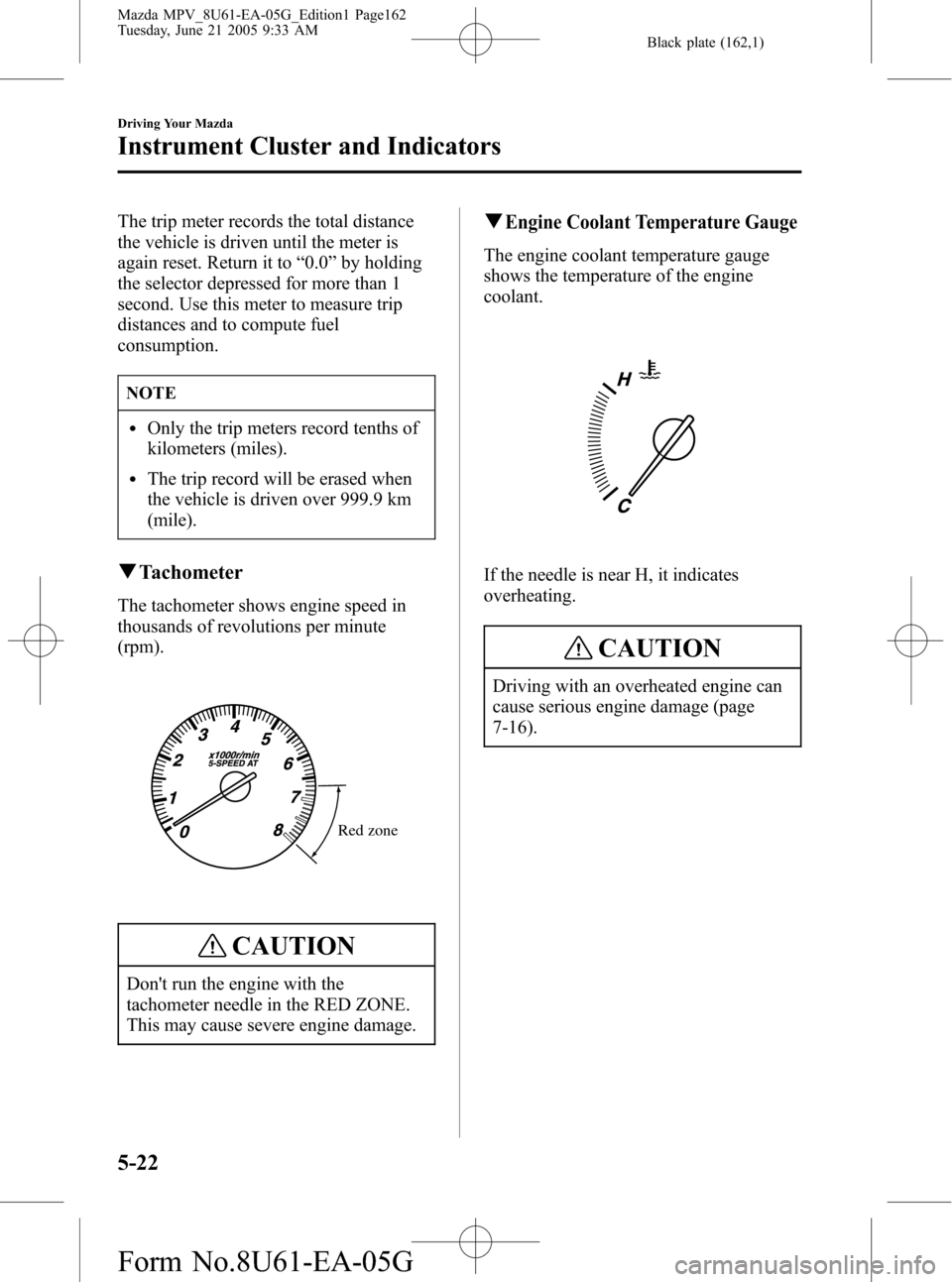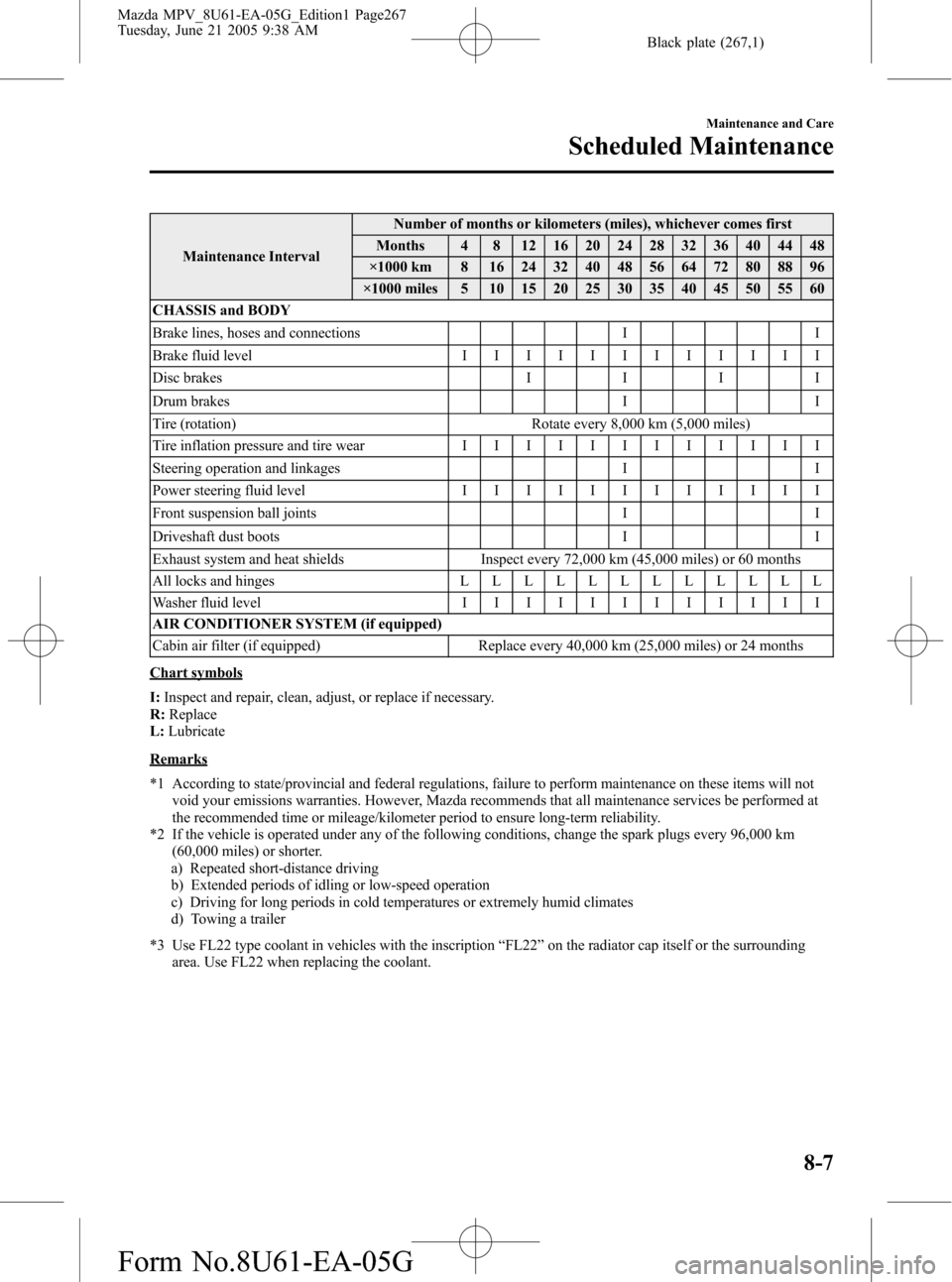coolant temperature MAZDA MODEL MPV 2006 Owners Manual (in English)
[x] Cancel search | Manufacturer: MAZDA, Model Year: 2006, Model line: MODEL MPV, Model: MAZDA MODEL MPV 2006Pages: 364, PDF Size: 5.67 MB
Page 160 of 364

Black plate (160,1)
Meters and Gauges
Speedometer ...................................................................................................... page 5-21
Odometer, Trip Meter and Selector .................................................................... page 5-21
Tachometer ........................................................................................................ page 5-22
Engine Coolant Temperature Gauge .................................................................. page 5-22
Fuel Gauge ........................................................................................................ page 5-23
5-20
Driving Your Mazda
Instrument Cluster and Indicators
Mazda MPV_8U61-EA-05G_Edition1 Page160
Tuesday, June 21 2005 9:33 AM
Form No.8U61-EA-05G
Page 162 of 364

Black plate (162,1)
The trip meter records the total distance
the vehicle is driven until the meter is
again reset. Return it to“0.0”by holding
the selector depressed for more than 1
second. Use this meter to measure trip
distances and to compute fuel
consumption.
NOTE
lOnly the trip meters record tenths of
kilometers (miles).
lThe trip record will be erased when
the vehicle is driven over 999.9 km
(mile).
qTachometer
The tachometer shows engine speed in
thousands of revolutions per minute
(rpm).
Red zone
CAUTION
Don't run the engine with the
tachometer needle in the RED ZONE.
This may cause severe engine damage.
qEngine Coolant Temperature Gauge
The engine coolant temperature gauge
shows the temperature of the engine
coolant.
If the needle is near H, it indicates
overheating.
CAUTION
Driving with an overheated engine can
cause serious engine damage (page
7-16).
5-22
Driving Your Mazda
Instrument Cluster and Indicators
Mazda MPV_8U61-EA-05G_Edition1 Page162
Tuesday, June 21 2005 9:33 AM
Form No.8U61-EA-05G
Page 252 of 364

Black plate (252,1)
Overheating
If the temperature gauge indicates
overheating, the vehicle loses power, or
you hear a loud knocking or pinging
noise, the engine is probably too hot.
WARNING
Cooling Fan and Engine
Inspection:
Inspecting the engine with the ignition
switch in the ON position is
dangerous. The cooling fan could turn
on unexpectedly even when the engine
isn't running. You could be seriously
injured by the fan. Turn the ignition
switch off and remove the key from the
ignition switch when you inspect the
engine.
Cooling System Cap:
When the engine and radiator are hot,
scalding coolant and steam may shoot
out under pressure and cause serious
injury. Don't remove the cooling
system cap when the engine and
radiator are hot.
Steam from Overheated Engine:
Steam from an overheated engine is
dangerous. The escaping steam could
seriously burn you. Open the hood
ONLY after steam is no longer
escaping from the engine.If the temperature gauge indicates
overheating:
1. Drive safely to the side of the road and
park off the right-of-way.
2. Shift into park (P).
Apply the parking brake.
3. Turn off the air conditioner.
4. Check whether coolant or steam is
escaping from under the hood or from
the engine compartment.
If steam is coming from the engine
compartment:
Don't go near the front of the vehicle.
Stop the engine.
Wait until the steam dissipates, then
open the hood and start the engine.
If neither coolant nor steam is
escaping:
Open the hood and idle the engine until
it cools.
CAUTION
If the cooling fan does not operate
while the engine is running, the engine
temperature will increase. Stop the
engine and call an Authorized Mazda
Dealer.
5. Make sure the cooling fan is operating,
then turn off the engine after the
temperature has decreased.
6. When cool, check the coolant level.
If it's low, look for coolant leaks from
the radiator and hoses.
7-16
In Case of an Emergency
Overheating
Mazda MPV_8U61-EA-05G_Edition1 Page252
Tuesday, June 21 2005 9:37 AM
Form No.8U61-EA-05G
Page 267 of 364

Black plate (267,1)
Maintenance IntervalNumber of months or kilometers (miles), whichever comes first
Months 4 8 12 16 20 24 28 32 36 40 44 48
×1000 km 8 16 24 32 40 48 56 64 72 80 88 96
×1000 miles 5 10 15 20 25 30 35 40 45 50 55 60
CHASSIS and BODY
Brake lines, hoses and connections I I
Brake fluid levelIIIIIIIIIIII
Disc brakesIIII
Drum brakes I I
Tire (rotation) Rotate every 8,000 km (5,000 miles)
Tire inflation pressure and tire wearIIIIIIIIIIII
Steering operation and linkages I I
Power steering fluid levelIIIIIIIIIIII
Front suspension ball joints I I
Driveshaft dust boots I I
Exhaust system and heat shields Inspect every 72,000 km (45,000 miles) or 60 months
All locks and hingesLLLLLLLLLLLL
Washer fluid levelIIIIIIIIIIII
AIR CONDITIONER SYSTEM (if equipped)
Cabin air filter (if equipped) Replace every 40,000 km (25,000 miles) or 24 months
Chart symbols
I:Inspect and repair, clean, adjust, or replace if necessary.
R:Replace
L:Lubricate
Remarks
*1 According to state/provincial and federal regulations, failure to perform maintenance on these items will not
void your emissions warranties. However, Mazda recommends that all maintenance services be performed at
the recommended time or mileage/kilometer period to ensure long-term reliability.
*2 If the vehicle is operated under any of the following conditions, change the spark plugs every 96,000 km
(60,000 miles) or shorter.
a) Repeated short-distance driving
b) Extended periods of idling or low-speed operation
c) Driving for long periods in cold temperatures or extremely humid climates
d) Towing a trailer
*3 Use FL22 type coolant in vehicles with the inscription“FL22”on the radiator cap itself or the surrounding
area. Use FL22 when replacing the coolant.
Maintenance and Care
Scheduled Maintenance
8-7
Mazda MPV_8U61-EA-05G_Edition1 Page267
Tuesday, June 21 2005 9:38 AM
Form No.8U61-EA-05G
Page 274 of 364

Black plate (274,1)
Engine Coolant
qInspecting Coolant Level
WARNING
Hot Engine:
A hot engine is dangerous. If the
engine has been running, parts of the
engine compartment can become very
hot. You could be burned. Carefully
inspect the engine coolant in the
coolant reservoir, but do not open it.
Do not use a match or live flame in the
engine compartment. DO NOT ADD
COOLANT WHEN THE ENGINE IS
HOT.
Cooling Fan and Engine
Inspection:
Inspecting the engine with the ignition
switch in the ON position is
dangerous. The cooling fan could turn
on unexpectedly even when the engine
isn't running. You could be seriously
injured by the fan. Turn the ignition
switch off and remove the key from the
ignition switch when you inspect the
engine.
Cooling System Cap:
When the engine and radiator are hot,
scalding coolant and steam may shoot
out under pressure and cause serious
injury. Don't remove the cooling
system cap when the engine and
radiator are hot.Inspect the antifreeze protection and
coolant level in the coolant reservoir at
least once a year―at the beginning of the
winter season―and before traveling
where temperatures may drop below
freezing.
Inspect the condition and connections of
all cooling system and heater hoses.
Replace any that are swollen or
deteriorated.
The coolant should be at full in the
radiator and between the F and L marks
on the coolant reservoir when the engine
is cool.
If it's at or near L, add enough coolant to
the coolant reservoir to provide freezing
and corrosion protection and to bring the
level to F.
CAUTION
Radiator coolant will damage paint.
Rinse it off quickly if spilled.
If the coolant reservoir is empty or new
coolant is required frequently, consult an
Authorized Mazda Dealer.
8-14
Maintenance and Care
Owner Maintenance
Mazda MPV_8U61-EA-05G_Edition1 Page274
Tuesday, June 21 2005 9:38 AM
Form No.8U61-EA-05G
Page 276 of 364

Black plate (276,1)
To change coolant
WARNING
Removing the Cooling System Cap:
Removing the cooling system cap
while the engine is running or hot is
dangerous. This might lead to cooling
system and engine damage and could
result in serious injury from escaping
hot coolant or steam. Turn off the
engine and wait until it's cool. Even
then, be very careful when removing
the cap. Wrap a thick cloth around the
cap and slowly turn it
counterclockwise to the first stop.
Step back while the pressure escapes.
When you're sure all the pressure is
gone, press down on the cap―still
using a cloth―turn the cap, and
remove it.
1. Make sure the engine is not running
and it has cooled.
2. Remove the cooling system cap.
F
L
Tighten Loosen
TightenLoosen
3. Remove the radiator drain plug and
drain the coolant into a suitable
container. Properly dispose of the used
coolant.4. Flush out the system with running
water.
5. Drain the system completely. Insert and
tighten the plug. Add as much
ethylene-glycol-based coolant mixture
and water (or undiluted FL22) as
necessary to provide freezing and
corrosion protection.
6. In extremely cold climates, add the
mixture percentage recommended in
the coolant mixture percentage table.
7. Run the engine at idle with the cooling
system cap off. Slowly add additional
coolant if necessary.
8. At this point, wait until the engine
reaches normal operating temperature;
then depress the accelerator two or
three times. Add more coolant, if
necessary, until the system is full.
9. Install the cooling system cap. Inspect
all connections for leaks. Inspect the
level in the coolant reservoir one more
time and verify that the coolant level is
between the F and L marks.
qChanging Coolant (With Rear
Heater)
Have an Authorized Mazda Dealer change
the coolant according to the Scheduled
Maintenance (page 8-3).
8-16
Maintenance and Care
Owner Maintenance
Mazda MPV_8U61-EA-05G_Edition1 Page276
Tuesday, June 21 2005 9:38 AM
Form No.8U61-EA-05G
Page 361 of 364

Black plate (361,1)
D
Daytime Running Lights ................... 5-34
Defroster
Rear window .............................. 5-37
Dimensions ....................................... 10-5
Door Locks ......................................... 3-8
Driving In Flooded Area ................... 4-11
Driving Tips ........................................ 4-7
Automatic transaxle ................... 5-12
Break-in period ............................ 4-7
Driving in flooded area .............. 4-11
Hazardous driving ........................ 4-8
Money-saving suggestions ........... 4-7
Rocking the vehicle ...................... 4-9
Winter driving .............................. 4-9
E
Easy Closure ..................................... 3-12
Emergency Starting ........................... 7-18
Flooded engine ........................... 7-18
Jump-starting .............................. 7-19
Push-starting .............................. 7-22
Emergency Towing ........................... 7-23
Emission Control System .................... 4-3
Engine
Coolant ....................................... 8-14
Exhaust gas .................................. 4-5
Hood release .............................. 3-24
Oil .............................................. 8-11
Overheating ................................ 7-16
Starting ......................................... 5-3
Engine Compartment Overview ........ 8-10
Engine Coolant
Overheating ................................ 7-16
Engine Coolant Temperature
Gauge ................................................ 5-22
Exhaust Gas ........................................ 4-5
Exterior Care ..................................... 8-46
E
Eyeglass Holder ................................ 6-54
F
Flasher
Hazard warning .......................... 5-38
Headlights .................................. 5-33
Flat Tire ............................................... 7-3
Changing ...................................... 7-9
Spare tire and tool storage ............ 7-3
Fluids
Classification .............................. 10-4
Owner maintenance ..................... 8-8
Fog Lights ......................................... 5-35
Foot Brake .......................................... 5-4
Front Console ................................... 6-54
Front Seats
(Electrically Operated Seats) ............... 2-8
Front Seats
(Manually Operated Seats) ................. 2-3
Fuel
Filler lid and cap ........................ 3-23
Gauge ......................................... 5-23
Requirements ............................... 4-2
Tank capacity ............................. 10-4
Fuses ................................................. 8-39
Panel description ........................ 8-41
Replacement ............................... 8-39
G
Glove Box ......................................... 6-54
H
Hazard Warning Flasher .................... 5-38
Hazardous Driving .............................. 4-8
Index
11-3
Mazda MPV_8U61-EA-05G_Edition1 Page361
Tuesday, June 21 2005 9:38 AM
Form No.8U61-EA-05G